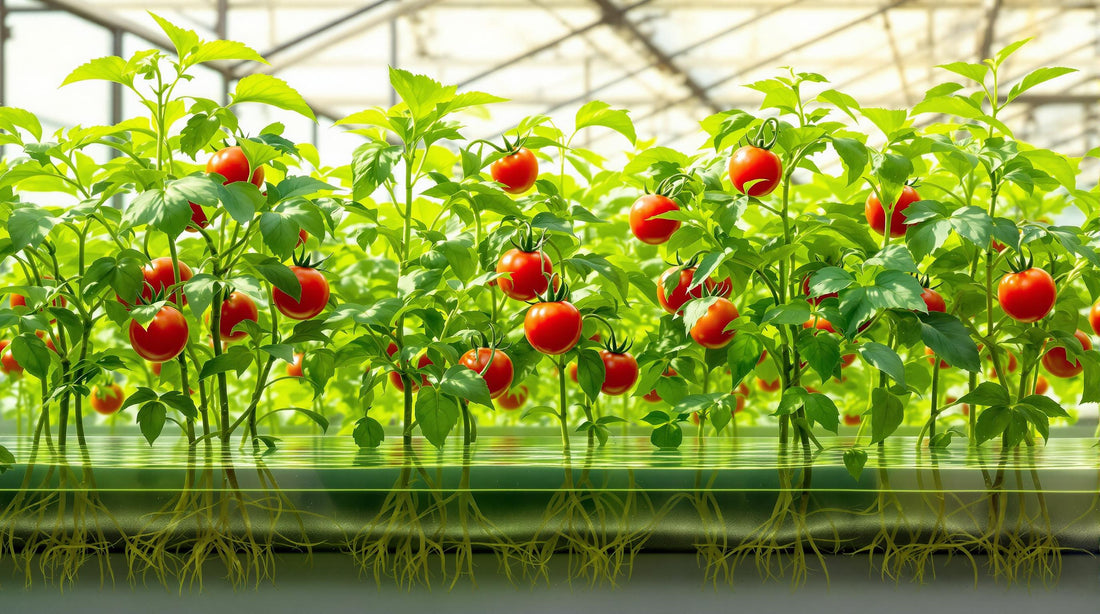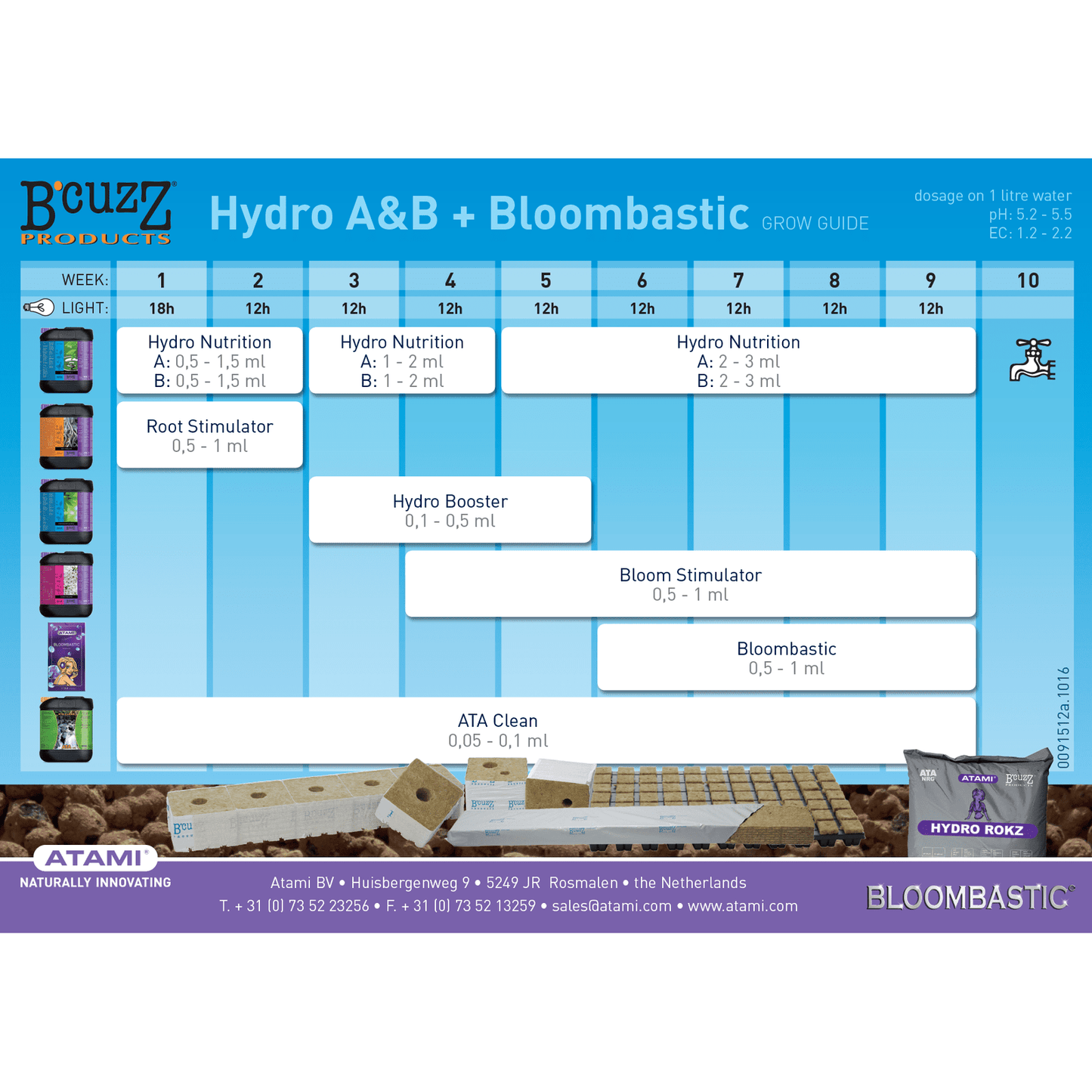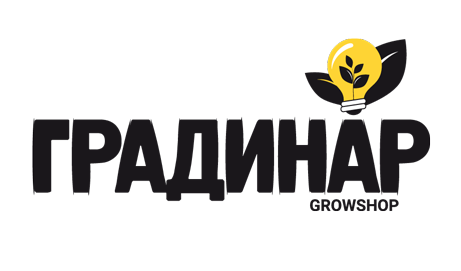
Hydroponics, tomatoes and tips for a successful harvest
Do you want to grow tomatoes faster and with higher yields? Hydroponic systems are your solution. They allow for up to 50% faster growth , 2-4 times more fruit per square meter , and save up to 90% water . Here's how to get started:
Choosing a hydroponic system
The hydroponic system you choose depends on your level of experience and needs:
• Deep Water Culture (DWC) for beginners. Especially easy to watch using the Short method.
• Nutrient Film Technique (NFT) and drip systems for advanced users.
Suitable varieties
Choose indeterminate tomato varieties, such as:
• Sun Gold
• Trust
Nutrient solution
Properly balancing the nutrient solution is key. Maintain:
• pH between 5.5-6.5
• EC according to the growth phase (usually 2.0 - 2.5 for the entire cycle).
• Check values every 2 weeks for the Short method and more frequently for other systems.
Lighting
Use LED lamps with the correct spectrum and intensity. Recommended products:
Climate control
Follow the main parameters:
• Temperature: 18-27°C
• Humidity: 60-80%
Follow these steps to grow delicious tomatoes year-round. In the following sections, we'll go over each step in more detail.
Growing tomatoes in hydroponics
Growing tomatoes hydroponically requires careful planning and the right system selection. This is the key to achieving high yields and sustainable growth.
1. A suitable hydroponic system
Choosing the right system depends on your level of experience and the resources available to you. Basic options:
• NFT (Nutrient Film Technique): Suitable for more experienced gardeners.
• DWC (Deep Water Culture): Ideal for beginners.
• The Short Method: Easy to perform, no need for pumps or electricity.
• Drip irrigation: Excellent for precision feeding, especially in commercial settings.
Details about the systems:
• The Short Method
A passive system where the water does not circulate and its level decreases over time. This allows the roots to receive oxygen directly. This system is economical and requires minimal maintenance.
Quick video on the Short Method
• DWC (Deep Water Culture)
Similar to the Short method, but with an oxygen-enriched nutrient solution. Suitable for small home installations, it is easy to set up and maintain.
• Drip irrigation
For experienced gardeners. Allows high control over nutrients and increases yields by up to 15% compared to traditional systems.
Example: The Wilma 8×18L system offers excellent efficiency and easy setup.
System comparison:
|
System |
Advantages |
Disadvantages |
Suitable for |
|---|---|---|---|
|
DWC |
Easy to maintain, low cost |
Requires a large amount of water |
Beginners |
|
NFTs |
Water saving, compactness |
Need for technical skills |
Experienced gardeners |
|
Kapkova |
Precise control, easy expansion |
High initial investment |
Commercial production |
Tips for choosing:
• Consider your space and budget.
• Estimate the volume of production you plan.
• Make sure you have the necessary technical skills for the chosen system.
Once you have chosen a system, move on to choosing suitable tomato varieties.
2. Suitable tomato varieties for hydroponics
After choosing a hydroponic system, the right tomato variety is a key factor for success. Indeterminate varieties are preferred as they provide a long fruiting period.
Recommended varieties:
• Cherry tomatoes: Sun Gold and Sweet Million are known for their high productivity and sweet taste.
• Beefsteak tomatoes: Trust and Geronimo offer large, fleshy fruit.
• Plum tomatoes: Roma VF and Tourance are ideal for sauces.
What to look for in varieties:
• Compact growth for vertical systems.
• Resistance to diseases, such as fusarium wilt.
• Good adaptation to indoor conditions.
• Efficient absorption of nutrients.
Here are some of the best varieties for hydroponic growing:
|
Variety |
Features |
Productivity |
|---|---|---|
|
Cherry (Sun Gold, Sweet Million ) |
Small, sweet fruits |
7-14 kg/plant, 50-70 days |
|
Steak (Trust, Geronimo ) |
Large, fleshy fruits |
9-18 kg/plant, 70-90 days |
|
Thick, suitable for sauces |
5-9 kg/plant, 70-80 days |
"For hydroponic systems, indeterminate varieties are best suited as they allow for continuous harvests and better use of space in vertical installations." - Dr. Lynette Morgan, hydroponic researcher
Once you have chosen the variety, it is time to balance the nutrient solution.
3. Balancing the nutrient solution
The right nutrient solution is a key factor for hydroponically grown tomatoes. It directly affects the yield and quality of the produce.
Main parameters:
|
Growth phase |
EC (mS/cm) |
pH |
Temperature |
Key elements (ppm) |
|---|---|---|---|---|
|
Seedlings |
1.0-1.5 |
5.8-6.3 |
20-22°C |
Number: 190-200 |
|
Vegetative growth |
2.0-2.5 |
5.8-6.3 |
20-22°C |
P: 50-55, K: 300-350 |
|
Flowering and fruiting |
2.5-3.5 |
5.8-6.3 |
20-22°C |
Ca: 170-180, Mg: 50-55 |
Maintaining the correct pH is important for preventing disease.
Tips for maintaining balance:
• Check pH and EC values at least twice a week.
• Use dark containers to prevent algae growth.
• Maintain the solution temperature between 18-24°C .
Problems and solutions:
• Yellow leaves: Lack of nitrogen or iron.
• Purple veins: Phosphorus deficiency.
• Brown leaf edges: Potassium deficiency.
• Rot at the base of the fruit: Calcium deficiency.
"Balancing nutrients in hydroponic tomato growing is both an art and a science. It requires constant monitoring and adjustments to achieve optimal results." - Dr. Lynette Morgan (hydroponics expert)
Recommended products for the nutrient solution:
• Hydro A+B by Plagron – combine with Sugar Royal and Calmag .
• B'Cuzz Hydro A+B together with Bloombastic .
• Advanced Hydroponics Grow + Bloom for high-quality results.
Example scheme when using Atami products:

Once you have mastered balancing the nutrient solution, move on to providing proper lighting.
4. Providing adequate lighting
Lighting is one of the most important elements for successful hydroponic tomato growing, especially if the system is indoors.
Recommended parameters:
|
Phase |
Intensity |
Duration |
Spectrum |
|---|---|---|---|
|
Seedlings |
200-300 micromoles/m²/sec |
2-4pm |
6500K |
|
Vegetation |
400-500 micromoles/m²/sec |
4-6pm |
5000K |
|
Fruiting |
500-600 micromoles/m²/sec |
2-4pm |
3000-4000K |
Advantages of LED lighting:
• Reduced energy consumption by up to 60% compared to HPS lamps.
• Long life – over 50,000 hours .
• Adjustable spectrum according to the needs of plants.
Recommended products:
"Proper lighting is crucial for hydroponic tomatoes. It's not just about intensity, but also spectrum and duration. The right combination of these factors can significantly affect fruit yield and quality." - Dr. Sarah Johnson
Practical tips:
• Line the walls with reflective materials to increase lighting efficiency.
• Maintain a distance of 15-30 cm between plants and LED grow lights.
• Ensure even light distribution to avoid uneven growth.
Symptoms of lighting problems:
• Elongated stems: Insufficient light.
• Leaf burns: The light is too strong or the lamps are too close.
• Uneven growth: Light is not evenly distributed.
• Pale leaves: The lighting is not long enough.
Once the lighting is set up correctly, the next important step is climate control – more on this in Tip 5.
Hydroponic systems are often used indoors, which makes the use of lights almost mandatory. But that doesn't mean you can't use your hydroponic system outdoors! You can grow your tomato crop on your balcony in a hydroponic system and achieve great results!
5. Temperature and humidity control
Even the best lighting and nutrient solution will not produce results if the climate is not under control.
Ideal parameters:
• Temperature: 18-27°C during the day, 15-20°C at night.
• Humidity: 65-80% (reduces to 60-70% during flowering).
• VPD (Vapor Pressure Deficit): 0.8-1.2 kPa during the day, 0.3-0.6 kPa at night.
How to maintain proper conditions:
• Use fans to circulate air.
• At temperatures above 27°C , use misting systems.
• Install thermal screens to retain heat at night.
Common problems:
• Cracked fruit: Sudden changes in humidity.
• Deformed colors: Temperatures above 32°C.
• Delayed ripening: Temperatures below 15°C.
6. Plant support and shaping
Tomatoes grown hydroponically do not typically benefit from the support of their root system that those grown in soil do. Therefore, support is even more important for hydroponic tomatoes. The appropriate method depends on the variety and system used:
Proper plant support and shaping play a key role in increasing yields in hydroponic tomatoes. The appropriate method depends on the variety and system used:
|
Method |
Application |
Advantages |
|---|---|---|
|
Vertical attachment |
Indeterminate varieties |
Optimal use of space |
|
Metal grilles |
Determinant varieties |
Provides stability for lower plants |
|
A-frame construction |
Universal |
Improves air circulation |
|
Horizontal network |
Cherry tomatoes |
Ideal for dense planting |
Styling techniques
For indeterminate varieties, as noted earlier (see Tip 2), the following steps are recommended:
• Regular removal of side branches.
• Carefully wrap the stem around the support.
• Fixing the stem every 20-30 cm.
“Properly supporting and shaping hydroponic tomatoes is not just a matter of supporting the plant. It’s about creating an optimal growing environment that maximizes light exposure, air circulation, and fruit accessibility.” - Dr. Chieri Kubota
Practical guidelines
To achieve the best results:
• Install the support system before planting.
• Use soft ties to avoid damaging the plants.
• Maintain a distance of 30-45 cm between plants.
• Remove the lower leaves to improve air circulation.
Once you have mastered these techniques, the next step is to ensure effective pollination indoors.
7. Ensuring pollination in indoor conditions
With hydroponic tomatoes, pollination requires an active approach. Once you have shaped your plants (see Tip 6), the next important step is pollination, a key process for producing fruit. Proper pollination can increase yields by 30-50% and improve the quality of your produce.
Conditions for successful pollination of tomatoes in hydroponics
|
Factor |
Ideal values |
Impact on pollination |
|---|---|---|
|
Temperature |
21-27°C |
Promotes pollen vitality |
|
Humidity |
50-70% |
Prevents pollen from sticking together |
|
Time |
Late morning |
Pollen is most active |
|
Frequency |
Every 1-2 days |
Improves success rate by 40% |
Methods for pollinating tomatoes in hydroponics
• Hand shaking or electric brush: This technique can increase efficiency by about 25%.
• Automated systems: Suitable for larger installations, providing up to a 20% increase in yield.
“Proper pollination is critical to fruit set in hydroponic tomatoes. Without it, you may see flower drop, no matter how well you manage other aspects of your system.”
– Dr. Chieri Kubota, Professor of Controlled Agriculture, Ohio State University
How to recognize successful pollination
• Small green fruits appear within a week.
• The flowers remain on the plant and begin to develop into fruit.
• Pollen is visible on the flowers.
• Tomatoes develop with a symmetrical shape.
Light air circulation also plays a role in pollen dispersal. Ventilating the room 1-2 times per hour can improve pollination by up to 40%. This practice is an excellent complement to climate control (see Tip 5), creating suitable conditions for plant development.
8. Disease prevention
Disease prevention is key to successfully growing tomatoes in a hydroponic system. With the right approach, the risk of disease can be reduced by up to 78% throughout the growing season.
As mentioned under climate control (Tip 5), maintaining stable conditions plays an important role in limiting pathogens.
Main factors and preventive measures
|
Factor |
Optimal values |
Effect on prevention |
|---|---|---|
|
Air humidity |
< 85% |
Reduces the risk of fungal diseases by 60-70% |
|
Temperature |
Stable |
Limiting the development of pathogens |
System sterilization
• UV sterilization of the circulating solution eliminates over 99% of pathogens.
• Weekly disinfection of equipment with 3% hydrogen peroxide solution.
• Maintaining 50 ppm hydrogen peroxide in the nutrient solution.
Biological control
• Introducing beneficial microorganisms such as Trichoderma harzianum into the system can reduce the risk of Fusarium wilt by 70%.
“Prevention is always better than cure in hydroponic systems. A holistic approach to disease management, including environmental control, sanitation, and biological agents, can significantly reduce the risk of outbreaks.”
– Dr. John Smith, Plant Pathologist, Cornell University
Early detection of diseases
Regular checks, similar to those for nutritional balance (Tip 3), should include:
• Inspection of the roots (color and consistency) and leaves (color and presence of spots).
• Monitoring for unusual changes in growth.
For professional diagnosis and treatment of diseases, specialized biological plant protection products are available on the market that are effective against the most common pathogens.
9. Pest control
In hydroponic systems, pest management is extremely important for successful tomato cultivation. An integrated pest management (IPM) approach can reduce pesticide use by up to 90% by combining biological and physical methods that complement disease prevention measures (see Tip 8).
Preventive measures against tomato pests in hydroponics
Physical protections:
• Insect screens on the ventilation openings.
• UV-C light systems for pathogen containment.
• Sticky traps around support structures.
Monitoring:
• Check the underside of the leaves twice a week. These inspections are just as important as watching for nutritional imbalances (see Tip 3).
• You can learn more about protecting against plant diseases and pests in our blog posts.
Biological control
Using beneficial insects is an effective way to control without chemicals:
Using beneficial insects is an effective way to control without chemicals:
|
Pest |
Biological agent |
Efficiency |
Application |
|---|---|---|---|
|
Whiteflies |
Encarsia formosa |
High |
1-2 parasitic wasps per m² |
|
Mites |
Phytoseiulus persimilis |
Very high |
20-30 predatory mites per plant |
|
Aphids |
Aphidius colemani |
Medium to high |
1 wasp per m² |
“In hydroponic systems, prevention is key. Once pests are established, they can spread quickly due to the controlled environment and lack of natural predators.”
– Dr. John Smith, entomologist at the University of California, Davis
Organic solutions
If additional control is needed, you can use:
• Neem oil – suitable for a wide range of pests.
• Products such as SB Plant Invigorator , Diamond Shield , and Canna Cure can be used to prevent both pests and diseases. These products also have a positive effect on the plants.
Important: Make sure the products used are certified for hydroponic systems to avoid damaging the plants or contaminating the nutrient solution.
Climate control
Data from hydroponic farms shows that good air circulation can reduce pests by up to 85%. Effective climate control is a key factor in minimizing the risk of infestations.
10. Harvesting and storage of crops
Proper harvesting and storage of hydroponic tomatoes is key to preserving their flavor and quality. If done correctly, it can significantly extend the shelf life of the produce.
How to recognize the moment of harvest
To harvest tomatoes at their best, watch for the following signs:
• Uniform and saturated color over the entire surface of the fruit.
• Slight softness at the bottom of the tomato.
• For cherry tomatoes – easy separation from the stem with a slight twist.
Retraction technique
Use clean, sharp scissors, cutting the stem about 1.5 cm long. It is recommended to harvest during the cooler parts of the day.
Storage conditions
|
Parameter |
Optimal value |
Note |
|---|---|---|
|
Temperature |
12-15°C |
Avoid storing in the refrigerator. |
|
Humidity |
90-95% |
Prevents dehydration |
|
Sorting |
With the handle up |
Reduces pressure and bumps |
|
Expiration date |
3-5 days |
Under optimal conditions |
Maintain stable conditions to ensure best results.
How to reduce losses
To minimize losses:
• Sort the tomatoes according to their degree of ripeness.
• Keep them out of direct light.
• Keep them away from apples and bananas, as they release ethylene, which accelerates ripening.
• Check regularly for signs of spoilage.
• Avoid contact between healthy and damaged fruit to prevent the spread of disease.
By following these steps, you will keep your produce in excellent condition.
If you have any questions, call or come to the store!
Greetings,
The Growshop Gardener Team
